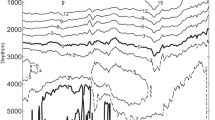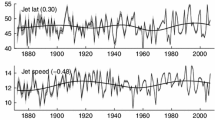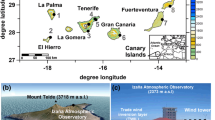Abstract
Near-inertial oscillations are ubiquitous in the ocean and are believed to play an important role in the global climate system. Studies on wind power input to near-inertial motions (WPI) have so far focused primarily on estimating the time-mean WPI, with little attention being paid to its temporal variability. In this study, a combination of atmospheric reanalysis products, a high-resolution ocean model and linear regression models are used to investigate for the first time the relationship between interannual variability of WPI in the North Atlantic and the North Atlantic Oscillation (NAO), motivated by the idea that the NAO serves as a good indicator for storminess over the North Atlantic and that storms account for the majority of WPI. It is found that WPI at low and high latitudes of the North Atlantic is significantly correlated to the NAO, owing to its influence on the configuration of the storm track. Positive (negative) NAO conditions are associated with increased WPI in the subpolar (subtropical) ocean. Basin-wide WPI is found to be significantly enhanced under negative NAO conditions, but is not significantly different from the climatological average under positive NAO conditions. This indicates a weak inverse relationship between basin-wide WPI and the NAO, contradicting intuitive expectations. The asymmetric impact of the NAO on basin-wide WPI results from greater sensitivity of WPI to near-inertial wind forcing at lower latitudes due to the variation of the Coriolis parameter with latitude.










Similar content being viewed by others
Notes
The North Atlantic basin here refers to the region between 25° and 65° N and between 90° W and 0° E.
A common measure of the intermittency of a given time series is kurtosis. Indeed, the spatial distribution of NIWSM kurtosis supports the following argument (not shown).
References
Alford MH (2003) Improved global maps and 54-year history of wind-work on ocean inertial motions. Geophys Res Lett 30:1424. doi:10.1029/2002GL016614
Anderson DLT, Gill AE (1979) Beta dispersion of inertial waves. J Geophys Res 84:1836–1842. doi:10.1029/JC084iC04p01836
Blackmon ML, Wallace JM, Lee Y-H (1984a) Horizontal structure of 500-mb height fluctuations with short, medium and long time scales. J Atmos Sci 41:784–812
Blackmon ML, Lee Y-H, Wallace JM, Hsu H-H (1984b) Time variation of 500 mb height fluctuations with long, intermediate and short time scales as deduced from lag-correlation statistics. J Atmos Sci 41:981–991
Chang S, Anthes R (1978) Numerical simulations of the ocean’s nonlinear, baroclinic response to translating hurricanes. J Phys Oceanogr 8:468–480
D’Asaro EA (1985) The energy flux from the wind to near-inertial motions in the surface mixed layer. J Phys Oceanogr 15:1043–1059
Furuichi N, Hibiya T, Niwa Y (2008) Model-predicted distribution of wind-induced internal wave energy in the world’s oceans. J Geophys Res Oceans 113, C09034. doi:10.1029/2008JC004768
Garret C (2001) What is the “near-inertial” band and why is it different from the rest of the internal wave spectrum? J Phys Oceanogr 4:962–971
Gill AE (1984) On the behaviour of internal waves in the wakes of storms. J Phys Oceanogr 14:1129–1150
Greatbatch RJ (1983) On the response of the ocean to a moving storm: the nonlinear dynamics. J Phys Oceanogr 13:357–637
Greatbatch RJ (2000) The North Atlantic Oscillation. Stoch Env Res Risk A 14:0213–0242
Guan S, Zhao W, Huthnance J, Tian J, Wang J (2014) Observed upper ocean response to typhoon Megi (2010) in the Northern South China Sea. J Geophys Res Oceans 119:3134–3157
Gulev SK, Zolina O, Grigoriev S (2001) Extratropical cyclone variability in the Northern Hemisphere winter from the NCEP/NCAR reanalysis data. Clim Dyn 17:795–809
Hurrell JW (1995) Decadal trends in the North Atlantic Oscillation: regional temperatures and precipitation. Science 269:676–679
Hurrell JW, Kushnir Y, Ottersen G, Visbeck M (2003) The North Atlantic Oscillation: climate significance and environmental impact. Geophys Monogr Ser 134. doi:10.1029/GM134
Jiang J, Lu Y, Perrie W (2005) Estimating the energy flux from the wind to ocean inertial motions: the sensitivity to surface wind fields. Geophys Res Lett 32, L15610. doi:10.1029/2005GL023289
Jochum M, Briegleb BP, Danabasoglu G, Large WG, Norton NJ, Jayne SR, Bryan FO (2013) The impact of oceanic near-inertial waves on climate. J Clim 26:2833–2844. doi:10.1175/JCLI-D-12-00181.1
Kalnay E et al (1996) The NCEP/NCAR 40-year reanalysis project. Bull Am Meteorol Soc 77:437–471
Kunze E (1985) Near-inertial wave propagation in geostrophic shear. J Phys Oceanogr 15:544–565
Large W, McWilliams J, Doney S (1994) Oceanic vertical mixing: A review and a model with a nonlocal boundary layer parameterization. Reviews of Geophysics 32:363–403
Lau N-C (1988) Variability of the observed midlatitude storm tracks in relation to low-frequency changes in the circulation pattern. J Atmos Sci 45:2718–2743
Lee D-K, Niiler PP (1998) The inertial chimney: the near-inertial energy drainage from the ocean surface to the deep layer. J Geophys Res 103:7579–7591
Marshall J, Adcroft A, Hill C, Perelman L, Heisey C (1997) A finite-volume, incompressible Navier Stokes model for studies of the ocean on parallel computers. J Geophys Res Oceans (1978–2012) 102:5753–5766
Munk W, Wunsch C (1998) Abyssal recipes II: energetics of tidal and wind mixing. Deep-Sea Res 45:1977–2010
Oort AH, Anderson LA, Peixoto JP (1994) Estimates of the energy cycle of the oceans. J Geophys Res Oceans 99:7665–7688
Plueddemann AJ, Farrar JT (2006) Observations and models of the energy flux from the wind to mixed-layer inertial currents. Deep-Sea Res 53:5–30
Pollard RT, Millard RCJ (1970) Comparison between observed and simulated wind-generated inertial oscillations. Deep-Sea Res 17:153–175
Price JF (1981) Upper ocean response to a hurricane. J Phys Oceanogr 11(2):153–175
Rath W (2013) The influence of ocean-surface-velocity-dependent wind stress on the dynamics of the Southern Ocean: the near-inertial and the sub-inertial response. PhD thesis, Christian-Albrechts-Universität Kiel, 113 pp
Rath W, Greatbatch RJ, Zhai X (2013) Reduction of near-inertial energy through the dependence of wind stress on the ocean-surface velocity. J Geophys Res Oceans 118:2761–2773. doi:10.1002/jgrc.20198
Rath W, Greatbatch RJ, Zhai X (2014) On the spatial and temporal distribution of near-inertial energy in the Southern Ocean. J Geophys Res Oceans 119:359–376. doi:10.1002/2013JC009246
Rimac A, von Storch JS, Eden C, Haak H (2013) The influence of high-resolution wind stress field on the power input to near-inertial motions in the ocean. Geophys Res Lett 40:4882–4886. doi:10.1002/grl.50929
Rogers JC (1997) North Atlantic storm track variability and its association to the North Atlantic Oscillation and climate variability of northern Europe. J Clim 10:1635–1647
Thomson RE (1983) A comparison between computed and measured oceanic winds near the British Columbia coast. J Geophys Res Oceans 88:2675–2683
Von Storch H, Zwiers FW (1999) Statistical analysis in climate research. Cambridge University Press, Cambridge, 495 pp
Wallace JM, Gutzler DS (1981) Teleconnections in the geopotential height field during the Northern Hemisphere winter. Mon Weather Rev 109:784–812
Wallace JM, Lim G-H, Blackmon ML (1988) Relationship between cyclone tracks, anticyclone tracks and baroclinic waveguides. J Atmos Sci 45:439–462
Watanabe M, Hibiya T (2002) Global estimates of the wind-induced energy flux to inertial motions in the surface mixed layer. Geophys Res Lett 29:2–5
Wunsch C (1998) The work done by the wind on the oceanic general circulation. J Phys Oceanogr 28:2332–2340
Zhai X, Marshall DP (2013) Vertical eddy energy fluxes in the North Atlantic subtropical and subpolar gyres. J Phys Oceanogr 43:95–103
Zhai X, Greatbatch RJ, Zhao J (2005) Enhanced vertical propagation of storm-induced near-inertial energy in an eddying ocean channel model. Geophys Res Lett 32, L18602. doi:10.1029/2005GL023643
Zhai X, Greatbatch RJ, Eden C (2007) Spreading of near-inertial energy in a 1/12° model of the North Atlantic Ocean. Geophys Res Lett 34, L10609. doi:10.1029/2007GL029895
Zhai X, Greatbatch RJ, Eden C, Hibiya T (2009) On the loss of wind-induced near-inertial energy to turbulent mixing in the upper ocean. J Phys Oceanogr 39:3040–3045
Acknowledgments
We thank Sergey Gulev and Natalia Tilinina of the P. P. Shirshov Institute of Oceanology of the Russian Academy of Sciences for kindly providing the storm path data. Numerical model experiments were carried out on the High Performance Computing Cluster supported by the Research and Specialist Computing Support service at the University of East Anglia. RJG and WR are grateful for the support from the GEOMAR. We would also like to thank two anonymous reviewers for their helpful comments.
Author information
Authors and Affiliations
Corresponding author
Additional information
Responsible Editor: Chris Wilson
This article is part of the Topical Collection on Atmosphere and Ocean Dynamics: A Scientific Workshop to Celebrate Professor Dr. Richard Greatbatch’s 60th Birthday, Liverpool, UK, 10–11 April 2014
Rights and permissions
About this article
Cite this article
Dippe, T., Zhai, X., Greatbatch, R.J. et al. Interannual variability of wind power input to near-inertial motions in the North Atlantic. Ocean Dynamics 65, 859–875 (2015). https://doi.org/10.1007/s10236-015-0834-x
Received:
Accepted:
Published:
Issue Date:
DOI: https://doi.org/10.1007/s10236-015-0834-x




